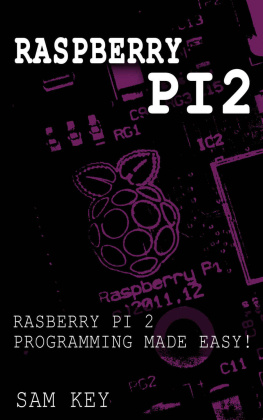This book is dedicated to allthose technical geeks like me.
Chapter 1- The New Age of Programming- What is Raspberry Pi?
In2006 colleagues at the University of Cambridge's Computer Lab, including EbenUpton and Rob Mullins, put forth the idea of building an inexpensive simpleboard computer to stimulate kids to learn computer programming. The idea grewout of recognition of the rapid decline in the preparedness level of studentsentering Computer Science curricula. During the computer technology revolutionof the 90's it was common for students to apply as experienced hobbyprogrammers. But in recent years, students applying often had little more thana bit of web design experience.
Theinteraction kids were having with computers had shifted from a technicalfascination and hobby subject, to a usury role in which computers were used forgaming and online browsing. As simple computer platforms like the Amigas,Spectrums, Commodores, and Texas Instruments disappeared, and so did thelearning tools that fed a generation of future programmers. High schoolcurricula reinforced that educational path by shifting to an emphasis on officeproducts such as Word and Excel, or web page creation, in response to a demandfor graduates with office skills.
EbenUpton and Rob Mullins reasoned that if an inexpensive and bare bones computerplatform could be made available that would boot into a programming environmentsimilar to those early home computers, interest in hobby programming could berekindled in kids. Out of that idea the Raspberry Pi computer platform wascreated, and the Raspberry Pi Foundation was formed.

By2008 mobile devices were pushing the development of powerful processors withfull multimedia features. By creating a platform that could plug intomultimedia display and be programmed with sophisticated graphics thedevelopment team believed it would be more appealing to kids than a purelyprogramming-oriented device.
Thusin 2011 the Raspberry Pi micro-computer platform went into mass production witha target price of just $25 for a bare bones Model A, or $35 for a slightlyamped up version with more memory and extra I/O ports.
Rightout of the gate there was enormous interest from educational communities aswell as many organizations outside the foundations original target. There wasinterest from developing countries looking for alternatives to power hungrydesktop computers, hospitals and museums looking for ways to drive interactivedisplays, accessibility applications for the disabled, and of course thousandsof hobbyists building robots. In their first year more than 1 million unitshave been sold.
SoWhat Are The Capabilities Of The Raspberry Pi?
Physicallyit's not much larger than a credit card, measuring just 86mm long x 56mm wide,and just 21mm in height. It includes video output for both composite video, viaa standard RCA video jack, and HDMI video, via a standard mini-HDMI connector.It also provides audio output via a standard jack (as well as audio on HDMI),one USB2.0 port (2xUSB for Model B), an Ethernet port, General Purpose I/O(GPIO), and a slot for a Micro-SD card, from which it boots, and to uploadprogramming code. The model A includes 256 Mbytes of RAM and the model B provides512 Mbytes.
Atthe heart of the Raspberry Pi, is Broadcom's powerful BCM2835 dual-core videoprocessor, designed for full HD streaming media, graphics, 3D gaming, and BlueRay quality playback. The Raspberry Pi is shipped with both OpenGL and OpenVGgraphics library for programming.
Overallthe performance is on par with Sony's X box I or a 300 MHz Pentium II but withgraphics on steroids. In short, it's a very powerful little programmingplatform that should tweak the interest of any kid with a passion for tinkeringand exploring.
Therecommended operating system is Debian, a Linux distribution, which is thedefault distribution available from Raspberry Pi. It's loaded from the SD cardat boot up, though once booted, programming can be taken over from an externalUSB drive via one of the ports. On that note, it should be pointed out thateven the enhanced Model B is limited to just two USB ports, so from a practicalstandpoint a programmer will need a USB hub through which to connect akeyboard, mouse, USB drive if one is used, and any other peripherals.
TheRaspberry Pi Is Finding Community Support
Avery active user forum has sprung up on the raspberrypi.org site, withthousands of posts for discussing basic setup and usage, Linux user help,trouble shooting, and software issues.
Oneof the most popular programming languages on the Raspberry Pi right now appearsto be the Python language. Python is a high level open source programminglanguage, meaning it's free. It has lots of development tools and is wellsupported by the online community. One of its popular features is a veryreadable code structure, making it a nice choice for beginners. Raspberry Piprogrammers are using Python for a variety of applications and to create gamesand graphical displays.
Thereare a surprising number of blogs and websites that have been dedicated toprogramming and using the Raspberry Pi. Whether a beginner is learning toprogram with Python, or a more advanced programmer looking for tips to programthe Raspberry Pi in the C language, there are a number of tutorial sites, andproject oriented sites.
Justa quick Google search will reveal dozens and dozens of websites reporting noveluses of the Raspberry Pi tips on programming, accessories to buy, and so on.There are even projects on Kick Starter looking for funding. In the eighteenmonths since it went into production, it has caught on like few products orinnovations do today.
Lookingback on the early days when hobby programmers took up the Amigas, Spectrums,Commodores, and Texas Instruments platforms for experimenting, their supportnetwork was largely word of mouth, scattered magazines, and the antiquatedbulletin boards and chat room of AOL. One can only imagine the speed at whichkids can learn today with the Internet providing essentially an open classroom24/7. Perhaps these fellows have it right, and all it takes is the rightbuilding blocks and a little nudge to get the process of curiosity and creationflowing in young kids today.




